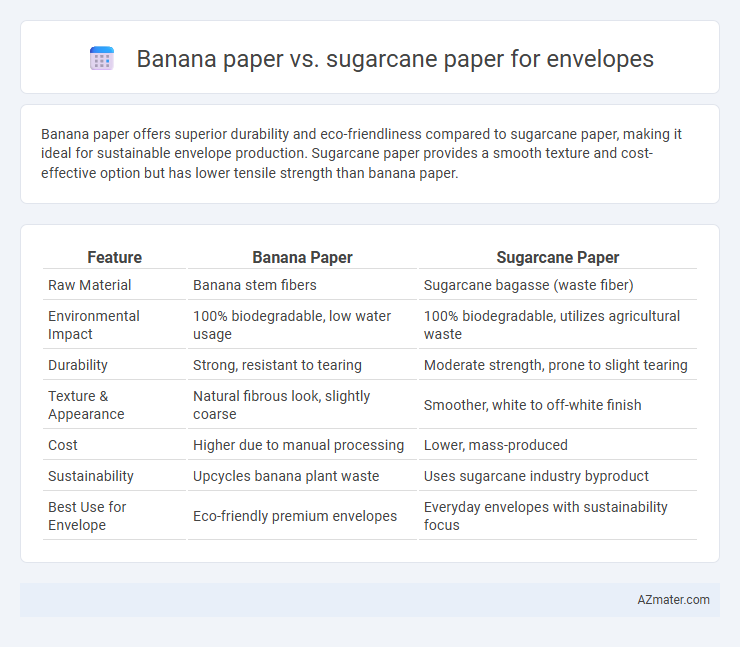Banana paper offers superior durability and eco-friendliness compared to sugarcane paper, making it ideal for sustainable envelope production. Sugarcane paper provides a smooth texture and cost-effective option but has lower tensile strength than banana paper.
Table of Comparison
| Feature | Banana Paper | Sugarcane Paper |
|---|---|---|
| Raw Material | Banana stem fibers | Sugarcane bagasse (waste fiber) |
| Environmental Impact | 100% biodegradable, low water usage | 100% biodegradable, utilizes agricultural waste |
| Durability | Strong, resistant to tearing | Moderate strength, prone to slight tearing |
| Texture & Appearance | Natural fibrous look, slightly coarse | Smoother, white to off-white finish |
| Cost | Higher due to manual processing | Lower, mass-produced |
| Sustainability | Upcycles banana plant waste | Uses sugarcane industry byproduct |
| Best Use for Envelope | Eco-friendly premium envelopes | Everyday envelopes with sustainability focus |
Introduction to Eco-Friendly Envelope Materials
Banana paper and sugarcane paper represent innovative eco-friendly envelope materials derived from agricultural waste, reducing reliance on traditional wood pulp. Banana paper is crafted from banana plant fibers, offering durability and a unique texture, while sugarcane paper utilizes bagasse, the fibrous residue left after extracting juice, promoting waste valorization. Both materials provide sustainable alternatives that minimize environmental impact through biodegradability and lower carbon footprints.
What is Banana Paper?
Banana paper is an eco-friendly material made from the fibers of banana plant stems, offering a sustainable alternative to traditional wood-pulp paper. It is durable, biodegradable, and naturally textured, making it ideal for envelope production with a rustic, organic aesthetic. Compared to sugarcane paper, which utilizes sugarcane bagasse, banana paper often provides higher fiber strength and unique tactile qualities suited for premium stationery.
What is Sugarcane Paper?
Sugarcane paper is a sustainable alternative made from bagasse, the fibrous residue left after extracting juice from sugarcane stalks, offering an eco-friendly option for envelope production. Compared to banana paper, sugarcane paper provides a smoother texture and higher durability, making it ideal for high-quality stationery and packaging. Its production reduces agricultural waste and consumes less water, contributing to lower environmental impact.
Environmental Impact Comparison
Banana paper envelopes generate less water pollution and require lower energy consumption than sugarcane paper, making them a more eco-friendly choice. Sugarcane paper production emits higher carbon dioxide levels due to the intensive processing of bagasse, whereas banana fiber extraction uses agricultural waste with minimal chemical inputs. Both alternatives reduce deforestation compared to traditional wood pulp paper, but banana paper offers superior biodegradability and compostability, further minimizing environmental footprint.
Production Processes: Banana vs Sugarcane Paper
Banana paper production involves extracting fibers from banana plant stems, which are cleaned, boiled, and pulped before being spread into sheets and dried, making it a sustainable choice by utilizing agricultural waste. Sugarcane paper, derived from bagasse--the fibrous residue after juice extraction--is processed through pulping, bleaching, and sheet formation, emphasizing waste-to-resource conversion in the sugar industry. Both methods capitalize on byproducts of agricultural crops, reducing deforestation and offering eco-friendly alternatives for envelope manufacturing.
Durability and Strength: Which Paper Lasts Longer?
Banana paper offers superior durability and tensile strength due to its long natural fibers, making envelopes more resistant to tearing and wear compared to sugarcane paper. Sugarcane paper, while eco-friendly and smooth, tends to have shorter fibers, resulting in lower durability under frequent handling or stress. For long-lasting envelope use where strength is critical, banana paper typically outperforms sugarcane paper by maintaining integrity over extended periods.
Printability and Appearance
Banana paper offers a unique textured surface with natural fiber patterns, enhancing printability by allowing vibrant ink absorption and sharp detail for envelopes. Sugarcane paper features a smoother finish and consistent color tone, providing excellent print clarity and a polished appearance ideal for high-quality envelope printing. Both papers support eco-friendly packaging, but banana paper stands out for its artisanal look while sugarcane paper excels in uniformity and professional aesthetics.
Cost and Availability
Banana paper and sugarcane paper vary significantly in cost and availability for envelope production; banana paper is generally more expensive due to its niche market and limited raw material supply. Sugarcane paper, derived from abundant agricultural waste, is more cost-effective and widely available, making it a preferred choice for large-scale envelope manufacturing. The regional availability of sugarcane byproducts ensures consistent production, whereas banana paper's availability fluctuates depending on local banana farming intensity.
Biodegradability and Recycling
Banana paper and sugarcane paper both offer excellent biodegradability, decomposing naturally within weeks and reducing environmental impact compared to conventional paper. Banana paper, made from banana plant fibers, tends to be more durable and breathable, while sugarcane paper, sourced from bagasse waste, often has a softer texture with comparable compostability. Both materials are recyclable and compatible with standard paper recycling processes, supporting circular economy practices and sustainable envelope production.
Choosing the Right Paper for Sustainable Envelopes
Banana paper and sugarcane paper both offer eco-friendly options for sustainable envelopes, with banana paper made from banana plant fibers providing high durability and a unique texture, while sugarcane paper utilizes bagasse, a byproduct of sugar production, ensuring efficient waste reduction. Sugarcane paper boasts a lower carbon footprint due to its renewable source and faster processing time, whereas banana paper excels in biodegradability and strength, ideal for premium, sturdy envelopes. Evaluating environmental impact, material strength, and production processes helps determine the best choice for sustainable envelope manufacturing tailored to specific brand values and product needs.

Infographic: Banana paper vs Sugarcane paper for Envelope
 azmater.com
azmater.com